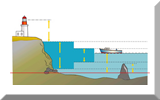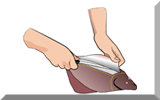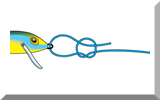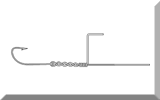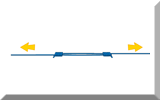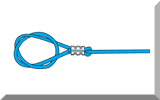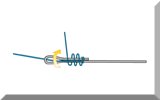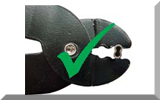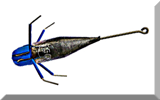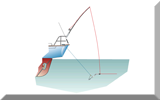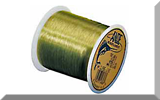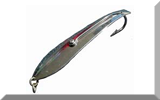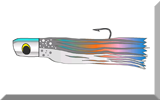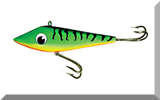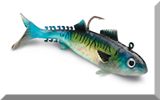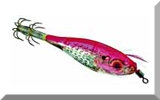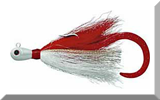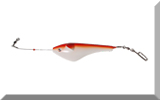| Clike here to read When, Where & How to Catch
Saltwater Boat Fishing
Tips, Tackle and Techniques
Most sea anglers get their first taste of saltwater boat fishing by booking a trip with a charter boat skipper - and many, with no desire or opportunity to own their own boat, continue to get all their boat angling this way.
Charter boat angling has tempted quite a few commercial fisherman away from inshore trawling, potting and longlining to the more dependable income to be gained from the pockets of saltwater anglers.
Many such skippers have won a high reputation due to having achieved consistently good results over the years, and are booked up weeks in advance as a result.
The Benefits of Charter Boat Fishing
Competition amongst charter boat skippers is high - they're highly incentivised to get good results for their paying customers - or they might not be back.
So there's much to be said for going boat fishing in this way. After all:~
- The charter boat skipper will have built up a great deal of local knowledge over the years. He'll know the best marks, and at what state of the tide they fish best.
- He'll have up to date nautical chartsaboard and with these, a tidal atlas and a set of tide tables he'll know the strength and direction of the currents to be expected at each of his planned fishing marks.
- His experience will enable him to advise on the best techniques for each mark, the most productive lures, and which fishing rigs to use for any particular species.
- Providing both he and the boat are licensed (and you should definitely check that they are), you can be confident that the boat is suitable for its intended purpose and the skipper is conversant with the rules and regulations associated with operating a boat at sea.
Boat Fishing Tips and Techniques
But whatever boat you're fishing from, there are three ways you can use it:~
- Underway, in which case trolling is the saltwater fishing technique to use, or
- adrift, when either jigging, freelining or bottom fishing is the way to go, or
- at anchor, where bottom fishing or jigging will be your best bet
So let's get to it, starting with ...
Trolling
This involves towing a lure - or a carefully rigged deadbait - some distance behind a moving boat. On the face of it, trolling's a simple boat fishing technique, but you'll need to think about ...
- Will a simple handline be best for this, or do I need a specialised outfit?
- What sort of lure should I use?
- What are the best ways of rigging natural baits?
- How far behind the boat should the lure be?
- How deep should I fish the lure, and how can I get it to stay at the chosen depth? Do I need a plastic paravane, or perhaps a stainless-steel planer, or even a full downrigger set up? What about wire line instead of monofilament?
- What's the best way of using a downrigger, and is there a way of cobbling together a homemade downrigger outfit?
- What's the best trolling speed?
- How can I attract more fish to my lure and get them interested in having a go?
- Will deploying two trolling lines double my hit rate?
- And what's all this about the drop-back method and nose-rigging with circle hooks?
Click Here to find the answers to all these questions about
Trolling For Fish ....
Jigging
I suspect like many other sea anglers, my earliest memory of saltwater fishing was jigging for mackerel from a drifting boat whilst on the annual south coast summer holiday with my parents. Tackle was pretty basic, as was the fishing technique - a handline, a string of mackerel feathers and a sinker, which were jerked up and down experimentally at various depths.
Results were sometimes spectacular. Six or more glistening, wriggling mackerel at a time - a cause of great jubilation when you could count your age on the fingers of two hands.
Although saltwater fishing techniques haven't changed much over the years, the tackle and our aspirations have. Mackerel feathers have been largely replaced by the more effective and robust Hokkai lures, the smallest of which are the ones to use when jigging for baitfish.
Jigging is the best way of plucking individual fish from the shoals that hang out above deepwater wrecks. Perks and soft-plastic lures - muppets, shads and jellyworms - will get the job done here.
Squid and octopus are also suckers (sorry) for the jig fishing technique, although they do demand specialised lures of their own.
But there's a lot more to jig fishing than jerking a lure up and down until you catch a fish or your arm drops off, so ...
Click Here for more information about Jig Fishing ...
On the Drift
As its name implies, drift fishing is done from a boat that's neither anchored nor underway, but just drifting with wind and current.
Here are a few examples where drift fishing regularly gets results:~
- In settled conditions freelining a live sandeel on the drift is a great way to nail a specimen bass.
- Plaice, flounders and other flatfish will pounce eagerly on a lugworm or ragworm baited hook as it trips seductively over a sandy seabed, drawn along by a slowly drifting boat.
- Drifting over a wreck with jigging tackle is a saltwater fishing technique that has probably produced more specimen pollack and coalfish than any other method.
- And shark anglers fish on the drift using a balloon float and whole mackerel bait, while laying out an enticingly fishy 'rubby-dubby' trail.
Click Here to find more about Drift Fishing ...
Bottom Fishing
Not on the drift as previously described, but from an anchored boat.
When bottom fishing, demersal fish will again be your quarry - that is, those kinds of fish that live and feed on the sea bed, or just above it. Flatfish, skates and rays, cod, haddock and whiting for example.
At slack water, with no tidal flow to carry it astern, you'll be able to drop your baited hooks vertically to the seabed - and the paternoster rig is the one to use.
But once the tide starts to run, your paternoster rig will be lifted up and swung clear of the bottom. Not good. Time to switch to a ledger rig. Now with a running ledger weight ahead of the hook trace, you can ease out your line until the weight holds bottom and your baited hook lays on the seabed astern of it. Providing your ledger weight is heavy enough and you let out enough line, it will stay put. This is the downtide ledger fishing technique.
Uptide ledgering is a more sophisticated technique in which the rig is cast uptide and away from the boat. A wire-spiked lead will hold it in place until a fish takes, whereon the lead will be pulled free, the whole shebang will trundle off downstream and your line will go slack - Strike!
Click Here to find about these Bottom Fishing Techniques ...
Boat Fishing Tackle
Charter boat captains often have a range of fishing outfits available for anglers that wish to borrow them, but most of us feel more comfortable with the fishing equipment that we've selected carefully from the vast choice that's available to us, and purchased with our own money. And its likely to have been a considerable investment, as no single outfit will fulfill all your boat fishing needs - and there'll be little, if any, interchangeability with your shore fishing rods and reels.
Boat Fishing Rods
To cater for the variety of species, techniques and venues you'll need different boat fishing rods for:~
- Downtiding
- Uptiding
- Trolling
- Jigging
And these will have been built up from blanks with specific power characteristics for a defined application. They'll be marked as being suitable for a limited range of casting weights, or with IGFA class ratings of 5lb, 10lb, 15lb, 20lb, 30lb, 50lb or 80lb.
The IGFA rods will all be provided with a gimbal end fitting for use with a butt pad, or fighting chair, and will come with a rubber pad to cover it when the gimbal fitting is not required.
Saltwater boat fishing rods designed for use with baitcast reels or conventional reels (both types known as multiplying reels in Europe) will differ from than those used with fixed spool spinning reels. Not only might they have different reel seats and but the the former will have more, and smaller, line guides than the latter.
The guides on a rod intended for use with ultra-thin braid lines must be of a higher quality than one used with mono line - and if you want to use wire line (not so popular these days, other than for wire line trolling, due to the development of ultra thin braids) then you'll need roller guides throughout.
Some boat fishing rods are made for the angler on the move - travel rods. These normally have four sections of around 27" (650mm) long and fit nicely into the boot (that's the trunk if you're an American) of a car, and can be carried as airline cabin baggage.
Other boat fishing rods are produced with a number of tip sections to cover casting weights and tide options, which eases the financial burden somewhat.
Boat Fishing Reels
There are three main types:~
- Multipliers (or Baitcast Reels and Conventional Reels in the USA)
- Fixed Spool reels (or Spinning Reels)
- Drum Reels
Multipliers (Conventional Reels)
Whilst multiplier reels are much more popular in the EURO than spinning (or fixed spool) reels, you'll need several to cover your boat fishing aspirations.
Perhaps from a 7000 class multiplier for your uptide casting outfit to a 50lb class two-speed big game boat fishing reel to subdue a hard-fighting sailfish - and several others in between.
And the choices don't stop there:~
- Do you prefer a lever drag, or are you happy with the less sensitive star drag clutch system?
- Perhaps a level wind system?
- Maybe you like the idea of a magnetic braking system on your uptiding multiplier?
See what I mean? Maybe you should think about a degree of specialisation ...
When purchasing new saltwater boat fishing gear, my advice would always be to buy the best that you can afford, and select from a range made by a recognised manufacturer.
Cheap gear, when you have to chuck it and replace it after a few outings, is anything but.
Spinning Reels (Fixed Spool Reels)
The only area in which a spinning reel beats a multiplier for boat fishing is when casting away from the boat, such as in uptide ledgering with braided lines or for freelining live-baits.
For all other non-casting applications a multiplier beats it hands down. Why? Well:~
- The bail arm is an unnecessary complication. Why go to the trouble of turning the line through 90degrees if you don't have to?
- A fixed spool reel is much inferior to a multiplier when cranking up a heavy, hard-fighting fish - a conger eel for example - that's desperate to get back to its lair.
- Fixed spool reels intended for saltwater use don't normally come with a two-speed option.
- The drag mechanism on a fixed spool reel can't match the power or smoothness of a multiplier's, particularly if the multiplier sports a lever drag.
- You can only use a fixed spool reel with monofilament or braided line - wire line is a definite no-no.
Convinced?
Drum Reels
Gone are the days of the old wooden, knuckle bashing drum reels - they've been replaced by the Alvey reel from Australia.
These are powerful, robust and have a elegant simplicity of design. They come with a smooth and powerful star drag or lever drag system and are perfect for use with a wire line.
Some models are designed to be turned through 90 degrees enabling a casting function, much in the way of a fixed spool reel. And yes, you can mark me down as a fan.
Fishing Line
You've got three types of main reel lines to choose from:~
- Nylon Monofilament Line
- Braided Line
- Single-strand Wire Line
Monofilament Lines for Boat Fishing
These are made from liquid nylon, by drawing it out in a single continuous strand until it has reached a predetermined thickness. Small diameter mono lines are made by continuing the drawing-out process until the desired thickness has been reached. Breaking strain is obviously related to diameter, so it will come as no surprise that thinner lines are less strong than thick ones.
Modern production processes ensure that today's mono lines are highly consistent in terms diameter and breaking strain when new, but this happy state of affairs soon changes after the line has been in use for a while.
Exposure to the sun causes a structural change in the line - ultra-violet degradation - to occur, and this together with the inevitable nicks and abrasions soon mean that the actual breaking strain of your mono line is only a fraction of what it said on the spool.
Fortunately, mono line is relatively cheap - and it's a wise angler that replaces it regularly.
Braid Lines for Boat Fishing?
Today's high-tech braid lines are ideal for boat fishing!
They provide a number of benefits when compared to mono line. For example:~
- They're much thinner for a given breaking strain, which means you can hold bottom with a lighter lead, and cast further when uptiding, and ...
- Unlike mono, braid is almost non-stretch. So, better bite detection at the rod tip and instant hook penetration on the strike, and ...
- Braid line has much higher abrasion resistance than mono - it will last much longer.
But a word of warning ...
Braid lines don't cast well on a multiplier reel, as the coils bed into one another on the spool when under tension on the retrieve. Next cast? A short, inaccurate one if you're lucky, and a bird's nest if you're not!
So for uptiding with braid, a fixed spool reel beats a multiplier every time.
But remember, if your casting on a boat with other anglers aboard, you'll need a shock leader - most charter boat skippers insist on it.
And just one more knot to learn - the rather unimaginatively named braid knot.
Single-Strand Wire Lines for Boat Fishing
Before braided lines proved their effectiveness for downtide ledgering in strong tides and deep water, most boat anglers kept a bespoke wire line outfit handy for this situation. This comprised a boat rod with roller guides throughout and a multiplier with a narrow, steel spool such as the Penn 49L Super Mariner.
The weight of wire line, together with its relatively small makes it a firm favourite for deep-water trolling. Particularly so for American anglers, where coupled with Bunker Spoon as the lure, a wire line trolling outfit has accounted for many a large striped bass.
The big problem with wire line is that a kink in it will weaken it dramatically, hence the use of the specialised tackle to keep this prospect as small a risk as possible.
Knots clearly can't be tied in single strand wire, and crimped connections won't work either. The only suitable way of making connections in single-strand wire is with a Haywire Twist.
Terminal Tackle for Saltwater Boat Fishing
By which we mean the bait rigs made up in monofilament for uptide and downtide fishing.
Two hooks are normally better than one, as two baits will produce a better scent trail than one, and give a fish double the chance of rattling your rod tip.
Three hooks may be even better - but no more, or you'll be asking for tangles and hang-ups on the retrieve. As a general rule, use a single-hook rig on broken ground and save the multi-hook rig for clear, snag-free seabeds.
Not sure how to make the various terminal tackle rigs up? Then cheat!
How? Buy one of each sort that you'll be likely to use from your tackle supplier - and copy them shamelessly.
Click Here to see a good selection of Top Quality Boat Rigs ...
These are the main ones for boat fishing with bait:~
- The Running Ledger Rig, made up with a flowing trace of a length appropriate to the strength of the tide and equipped with one, two or three hooks.
- The Flapper or Paternoster Rig, usually made up with three hooks on snoods (or droppers) formed by cut snood loops, three-way swivels or beads and crimps.
- The Portland Rig, a single hook, anti-tangle rig particularly suited for fishing a livebait.
- The Flatfish Rig, which needs no further explanation.
Make use of the two-hook Pennel Rig for larger baits.
And these are the ones to use when boat fishing with lures:~
- The Flying Collar Rig for drifting a lure over a wreck or broken ground
- The Hopper Rig, for tripping a shad along the bottom.
- The Ripping Rig, for jigging with a pirk or other metal jig along with flyers (often muppets).
Two of the knots you'll definitely need to know if you're to make up these boat fishing rigs successfully are the Uni-Knot and the Dropper Loop. | 
